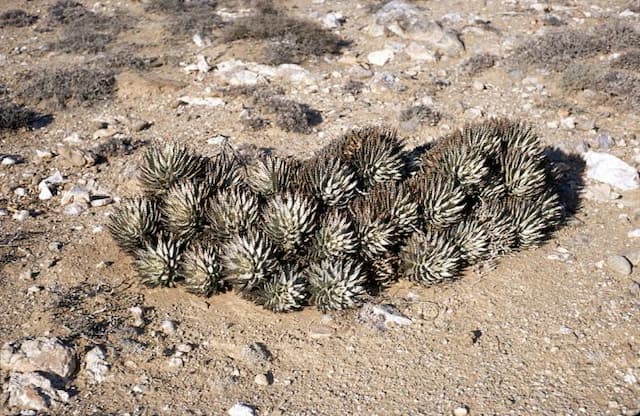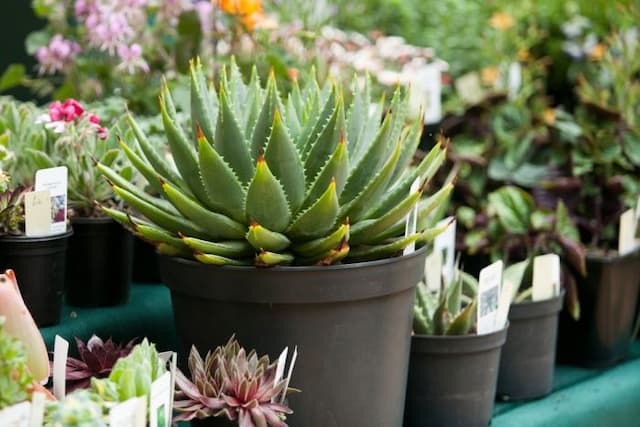Red Hot Poker Kniphofia 'Wol's Red Seedling'

ABOUT
The plant known as Kniphofia 'Wol's Red Seedling', commonly referred to as Red Hot Poker or Torch Lily, is recognized for its distinctive and striking flower spikes. The blooms range in color from a warm, fiery red at the top, gently blending into an appealing orange hue further down, and can be complemented by a yellowish base at the lowest part of the flower spike, creating a resemblance to a torch or a glowing poker. The flowers are tubular, closely set together, and form dense clusters on tall, upright stems that rise above the foliage. These stems emerge from a clump of grass-like, evergreen leaves that are narrow, arching, and rich green in color, giving the plant a lush, tufted appearance at the base. The distinctive flowering spikes of Red Hot Poker can add a touch of exotic flair to any garden, and they are especially favored for adding vertical interest without occupying much space. They also attract pollinators such as hummingbirds and butterflies, which find the tubular flowers irresistible. The plant's floral display is typically at its peak during the warmer months, bringing vibrant colors to the landscape when many other plants have ceased blooming.
About this plant
 Names
NamesFamily
Asphodelaceae
Synonyms
Red Hot Poker, Torch Lily, Tritoma
Common names
Kniphofia 'Wol's Red Seedling'
 Toxicity
ToxicityTo humans
The plant commonly known as Red Hot Poker is not widely recognized as poisonous to humans. There are usually no significant toxic effects reported from ingesting this plant. However, as with any plant material, individuals may experience varying degrees of sensitivity, and it may cause mild stomach upset or contact dermatitis in some people.
To pets
Red Hot Poker is also generally considered non-toxic to pets. Most animals will not experience severe symptoms if they ingest parts of this plant. Still, it might cause mild gastrointestinal upset, such as vomiting or diarrhea, particularly if consumed in large quantities. Always monitor your pets and contact a veterinarian if you suspect they have ingested any part of a plant and are showing signs of distress.
 Characteristics
CharacteristicsLife cycle
Perennials
Foliage type
Evergreen
Color of leaves
Green
Flower color
Red
Height
3-4 feet (0.9-1.2 meters)
Spread
2 feet (0.6 meters)
Plant type
Herb
Hardiness zones
6-9
Native area
South Africa
Benefits
 General Benefits
General Benefits- Attracts Pollinators: Its vibrant flowers draw in bees, butterflies, and hummingbirds, enhancing pollination in the garden.
- Drought Tolerance: Once established, it is quite resistant to drought, reducing the need for frequent watering.
- Seasonal Interest: It blooms in late spring to summer, providing vibrant red flowers that add seasonal color to the landscape.
- Low Maintenance: Requires minimal care once established, aside from occasional watering and removing spent flower spikes.
- Deer Resistance: Typically not preferred by deer, which can help maintain the integrity and beauty of the garden.
- Architectural Form: Adds visual interest with its upright, grass-like foliage and distinctive flower spikes.
- Perennial Lifespan: As a perennial, it comes back year after year, offering long-term presence in the garden.
- Soil Flexibility: Adapts to a variety of soil types, although it prefers well-drained soil.
 Medical Properties
Medical PropertiesThis plant is not used for medical purposes.
 Air-purifying Qualities
Air-purifying QualitiesThis plant is not specifically known for air purifying qualities.
 Other Uses
Other Uses- Artistic Inspiration: Kniphofia, commonly known as Red Hot Poker, can serve as a dramatic subject in garden photography and painting due to its bold colors and striking form.
- Culinary Garnish: The bright flowers of the Red Hot Poker can add visual interest when used as a non-toxic garnish for culinary dishes, though they are not commonly eaten.
- Educational Tool: Gardeners and educators can use the Red Hot Poker to teach about plant breeding, pollination, and the importance of selecting plants for their adaptability to climate conditions.
- Biological Indicator: Red Hot Poker might be used to indicate soil health in a garden since it prefers well-drained soils, hence its failure to thrive can indicate poor drainage conditions.
- Garden Structure: The vertical growth habit and striking coloration of Red Hot Poker can be used to provide vertical structure and height in garden design.
- Habitat Creation: Planting Red Hot Poker can contribute to creating habitat for nectar-seeking insects like butterflies and bees in gardens and public spaces.
- Seasonal Celebrations: Red Hot Poker's fiery appearance can be incorporated into fall-themed decorations, or events emphasizing warm colors.
- Contrast in Textile Design: The unique color and shape of the Red Hot Poker flower spike can inspire textile patterns that offer a contrast to more traditional floral designs.
- Ephemeral Art: The temporary yet beautiful nature of Red Hot Poker blooms allows for their use in creating short-lived works of art that change with the seasons.
- Dye Source: While not commonly practiced, the vibrant hues of Red Hot Poker could potentially be used as a natural dye source for fabrics or crafts.
Interesting Facts
 Feng Shui
Feng ShuiThe Red Hot Poker is not used in Feng Shui practice.
 Zodiac Sign Compitability
Zodiac Sign CompitabilityThe Red Hot Poker is not used in astrology practice.
 Plant Symbolism
Plant Symbolism- Hot Emotions: Kniphofia, commonly known as Red Hot Poker, has fiery-red flower spikes that evoke feelings of passion and intense emotion.
- Vibrancy: The bright and vivid colors of the Red Hot Poker signify liveliness and energy, suggesting a lively spirit and zest for life.
- Standing Out: With its striking appearance, the Red Hot Poker symbolizes being distinctive or standing out in a crowd.
- Attraction: The plant's bold hues can symbolize attraction or magnetism, perhaps indicating a strong and irresistible allure.
 Water
WaterRed Hot Poker plants, including the Kniphofia 'Wol's Red Seedling', prefer consistent moisture but do not like to be waterlogged. During the growing season, water the plant deeply once a week, providing about an inch of water each time. You can adjust this frequency slightly depending on the weather; water more during hot, dry spells and reduce the amount slightly during periods of rain. As a rough guideline, this translates to about 0.6 gallons for an average-sized plant. In the winter, when the plant is not actively growing, reduce watering to only when the soil is dry to the touch.
 Light
LightRed Hot Poker plants thrive in full sunlight. They need at least 6 hours of direct sun per day to develop their best flower spikes. The ideal spot for a Kniphofia 'Wol's Red Seedling' is an area that gets unobstructed sun from morning to midafternoon. Partial shade is acceptable, especially in hotter climates, but too much shade can reduce blooming and cause the plant to become leggy.
 Temperature
TemperatureThe Red Hot Poker plant is tolerant of a range of temperatures, but it grows best when the temperature is between 50°F and 86°F. It can survive minimum temperatures of around 14°F once established. Being a hardy plant, the Kniphofia 'Wol's Red Seedling' can also handle high summer temperatures well above the ideal range as long as they are watered properly.
 Pruning
PruningPruning Red Hot Poker plants, such as Kniphofia 'Wol's Red Seedling', is done to remove spent flower spikes and to tidy up any dead foliage. This helps encourage new growth and potentially more blooms. Cut the flower stalks down to the base of the plant after blooming, usually in late summer or fall. Additionally, in early spring, remove old, dead leaves to make way for new growth. Pruning yearly will help maintain the plant's attractive appearance.
 Cleaning
CleaningAs needed
 Soil
SoilRed Hot Poker thrives in well-drained soil with a pH between 6.0 and 7.0. A mixture of garden soil, sand, and compost is beneficial to ensure good drainage and fertility. Amend clay soils with organic matter to improve drainage and prevent root rot.
 Repotting
RepottingRed Hot Poker plants, like Kniphofia 'Wol's Red Seedling', generally do not need frequent repotting and can be repotted every 3-5 years or when they outgrow their current container.
 Humidity & Misting
Humidity & MistingRed Hot Poker plants are tolerant of a wide range of humidity levels and do not require high humidity, making them quite adaptable to average outdoor conditions.
 Suitable locations
Suitable locationsIndoor
Place in bright light and ensure pot has good drainage.
Outdoor
Full sun, well-drained spot, protect from severe frosts.
Hardiness zone
5-9 USDA
 Life cycle
Life cycleThe life cycle of Kniphofia 'Wol's Red Seedling', also known as Red Hot Poker, begins with seed germination, typically in the spring, given appropriate conditions of moisture and temperature. The seedlings develop roots and shoots, eventually growing into juvenile plants with a basal rosette of narrow, linear leaves. As the plants mature, they develop robust, upright flowering stems crowned with spikes of tubular flowers, ranging from red to orange and yellow. The blooming phase occurs during the summer months, attracting pollinators such as hummingbirds and bees. After pollination, seed capsules form, eventually drying and releasing seeds. The plant may also spread vegetatively through rhizomes, and is perennial, with foliage dying back in winter before resuming growth in the spring.
 Propogation
PropogationPropogation time
Spring to Summer
Propogation: Kniphofia 'Wol's Red Seedling', commonly known as Red Hot Poker, can be propagated effectively through division, which is the most popular method. This process is typically done in late winter or early spring before new growth starts. To propagate by division, carefully lift the plant from the ground with a spade, ensuring a large clump is intact. Then, using a sharp knife or spade, divide the clump into smaller sections, each with at least one growth point or fan of leaves. Replant the divisions promptly at the same soil depth they were previously growing, spacing them about 18 inches to 2 feet (45 to 60 centimeters) apart, and water thoroughly to establish. This method stimulates new growth and rejuvenates the plant, as well as increasing the number of plants in your garden.









